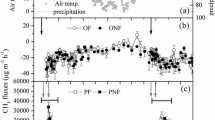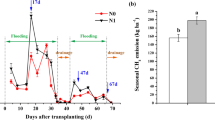Abstract
Background, aim, and scope
As the second most important greenhouse gas, methane (CH4) is produced from many sources such as paddy fields. Methane-oxidizing bacteria (methanotrophs) consume CH4 in paddy soil and, therefore, reduce CH4 emission to the atmosphere. In order to estimate the contribution of paddy fields as a source of CH4, it is important to monitor the effects of fertilizer applications on the shifts of soil methanotrophs, which are targets in strategies to combat global climate change. In this study, real-time polymerase chain reaction (PCR) and denaturing gradient gel electrophoresis (DGGE) based on 16S rRNA and pmoA genes, respectively, were used to analyze the soil methanotrophic abundance and community diversity under four fertilization treatments: urea (N), urea and potassium chloride (NK), urea, superphosphate, and potassium chloride (NPK), and urea, superphosphate, potassium chloride, and crop residues (NPK+C), compared to an untreated control (CON). The objective of this study was to examine whether soil methanotrophs responded to the long-term, different fertilizer regimes by using a combination of quantitative and qualitative molecular approaches.
Materials and methods
Soil samples were collected from the Taoyuan Experimental Station of Agro-ecosystem Observation at Changde (28°55′ N, 111°26′ E), central Hunan Province of China, in July 2006. Soil DNAs were extracted from the samples, then the 16S rRNA genes were quantified by real-time PCR and the pmoA genes were amplified via general PCR followed by DGGE, cloning, sequencing, and phylogenetic analysis. The community diversity indices were assessed through the DGGE profile.
Results
Except for NPK, other treatments of N, NK, and NPK+C showed significantly higher copy numbers of type I methanotrophs (7.0–9.6 × 107) than CON (5.1 × 107). The copy numbers of type II methanotrophs were significantly higher in NPK+C (2.8 × 108) and NK (2.5 × 108) treatments than in CON (1.4 × 108). Moreover, the ratio of type II to type I methanotrophic copy numbers ranged from 1.88 to 3.32, indicating that the type II methanotrophs dominated in all treatments. Cluster analyses based on the DGGE profile showed that the methanotrophic community in NPK+C might respond more sensitively to the environmental variation. Phylogenetic analysis showed that 81% of the obtained pmoA sequences were classified as type I methanotrophs. Furthermore, the type I-affiliated sequences were related to Methylobacter, Methylomicrobium, Methylomonas, and some uncultured methanotrophic clones, and those type II-like sequences were affiliated with Methylocystis and Methylosinus genera.
Discussion
There was an inhibitory effect on the methanotrophic abundance in the N and a stimulating effect in the NK and NPK+C treatments, respectively. During the rice-growing season, the type II methanotrophs might be more profited from such a coexistence of low O2 and high CH4 concentration environment than the type I methanotrophs. However, type I methanotrophs seemed to be more frequently detected. The relatively complex diversity pattern in the NPK+C treatment might result from the strong CH4 production.
Conclusions
Long-term fertilization regimes can both affect the abundance and the composition of the type I and type II methanotrophs. The inhibited effects on methanotrophic abundance were found in the N treatment, compared to the stimulated effects from the NK and NPK+C treatments. The fertilizers of nitrogen, potassium, and the crop residues could be important factors controlling the abundance and community composition of the methanotrophs in the paddy soil.
Recommendations and perspectives
Methanotrophs are a fascinating group of microorganisms playing an important role in the biogeochemical carbon cycle and in the control of global climate change. However, it is still a challenge for the cultivation of the methanotrophs, although three isolates were obtained in the extreme environments very recently. Therefore, future studies will be undoubtedly conducted via molecular techniques just like the applications in this study.



Similar content being viewed by others
References
Amaral JA, Knowles R (1995) Growth of methanotrophs in methane and oxygen counter gradients. FEMS Microbiol Lett 126:215–220
Amaral JA, Archambault C, Richards SR, Knowles R (1995) Denitrification associated with groups I and II methanotrophs in a gradient enrichment system. FEMS Microbiol Ecol 18:289–298
Babu YJ, Nayak DR, Adhya TK (2006) Potassium application reduces methane emission from a flooded field planted to rice. Biol Fertil Soils 42:532–541
Bender M, Conrad R (1995) Effect of CH4 concentrations and soil conditions on the induction of CH4 oxidation activity. Soil Biol Biochem 27:1517–1527
Bodelier PLE, Roslev P, Henckel T, Frenzel P (2000) Stimulation by ammonium-based fertilizers of methane oxidation in soil around rice roots. Nature 403:421–424
Conrad R, Klose M (2006) Dynamics of the methanogenic archaeal community in anoxic rice soil upon addition of straw. Eur J Soil Sci 57:476–484
Conrad R, Erkel C, Liesack W (2006) Rice Cluster I methanogens, an important group of Archaea producing greenhouse gas in soil. Curr Opin Biotechnol 17:262–267
Dubey SK, Singh JS (2000) Spatio-temporal variation and effect of urea fertilization on methanotrophs in a tropical dryland rice field. Soil Biol Biochem 32:521–526
Dunfield PF, Yuryev A, Senin P, Smirnova AV, Stott MB, Hou SB, Ly B, Saw JH, Zhou ZM, Ren Y, Wang JM, Mountain BW, Crowe MA, Weatherby TM, Bodelier PLE, Liesack W, Feng L, Wang L, Alam M (2007) Methane oxidation by an extremely acidophilic bacterium of the phylum Verrucomicrobia. Nature 450:879–882
Einola JKM, Kettunen RH, Rintala JA (2007) Responses of methane oxidation to temperature and water content in cover soil of a boreal landfill. Soil Biol Biochem 39:1156–1164
Fjellbirkeland A, Torsvik V, Øvreås L (2001) Methanotrophic diversity in an agricultural soil as evaluated by denaturing gradient gel electrophoresis profiles of pmoA, mxaF and 16S rDNA sequences. Antonie van Leeuwenhoek 79:209–217
Ge Y, Zhang JB, Zhang LM, Yang M, He JZ (2008) Long-term fertilization regimes affect bacterial community structure and diversity of an agricultural soil in northern China. J Soils Sediments 8:43–50
Hanson RS, Hanson TE (1996) Methanotrophic bacteria. Microbiol Rev 60:439–471
He JZ, Shen JP, Zhang LM, Zhu YG, Zheng YM, Xu MG, Di HJ (2007) Quantitative analyses of the abundance and composition of ammonia-oxidizing bacteria and ammonia-oxidizing archaea of a Chinese upland red soil under long-term fertilization practices. Environ Microbiol 9:2364–2374
He JZ, Zheng Y, Chen CR, He YQ, Zhang LM (2008) Microbial composition and diversity of an upland red soil under long-term fertilization treatments as revealed by culture-dependent and culture-independent approaches. J Soils Sediments 8:349–358
Henckel T, Friedrich M, Conrad R (1999) Molecular analyses of the methane-oxidizing microbial community in rice field soil by targeting the genes of the 16S rRNA, particulate methane monooxygenase, and methanol dehydrogenase. Appl Environ Microbiol 65:1980–1990
Holmes AJ, Roslev P, McDonald IR, Iversen N, Henriksen K, Murrell JC (1999) Characterization of methanotrophic bacterial populations in soils showing atmospheric methane uptake. Appl Environ Microbiol 65:3312–3318
Horz HP, Yimga MT, Liesack W (2001) Detection of methanotroph diversity on roots of submerged rice plants by molecular retrieval of pmoA, mmoX, mxaF, and 16S rRNA and ribosomal DNA, including pmoA-based terminal restriction fragment length polymorphism profiling. Appl Environ Microbiol 67:4177–4185
Hütsch BW (1998) Methane oxidation in arable soil as inhibited by ammonium, nitrite, and organic manure with respect to soil pH. Biol Fertil Soils 28:27–35
Intergovernment Panel on Climate Change (IPCC) (2007) Climate Change 2007: the physical science basis. Working Group I contribution to the fourth assessment report of the intergovernmental panel on climate change. Cambrigde University Press, Cambridge
Islam T, Jensen S, Reigstad LJ, Larsen Ø, Birkeland NK (2008) Methane oxidation at 55°C and pH 2 by a thermoacidophilic bacterium belonging to the Verrucomicrobia phylum. Proc Natl Acad Sci U S A 105:300–304
King GM (1997) Responses of atmospheric methane consumption by soils to global climate change. Glob Change Biol 3:351–362
Kolb S, Knief C, Stubner S, Conrad R (2003) Quantitative detection of methanotrophs in soil by novel pmoA-targeted real-time PCR assays. Appl Environ Microbiol 69:2423–2429
Krüger M, Frenzel P (2003) Effects of N-fertilisation on CH4 oxidation and production, and consequences for CH4 emissions from microcosms and rice fields. Glob Change Biol 9:773–784
Lowe DC (2006) Global change: a green source of surprise. Nature 439:148–149
Macalady JL, McMillan AMS, Dickens AF, Tyler SC, Scow KM (2002) Population dynamics of type I and II methanotrophic bacteria in rice soils. Environ Microbiol 4:148–157
Mohanty SR, Bodelier PLE, Floris V, Conrad R (2006) Differential effects of nitrogenous fertilizers on methane-consuming microbes in rice field and forest soils. Appl Environ Microbiol 72:1346–1354
Mohanty SR, Bodelier PLE, Conrad R (2007) Effect of temperature on composition of the methanotrophic community in rice field and forest soil. FEMS Microbiol Ecol 62:24–31
Murrell JC, McDonald IR, Bourne DG (1998) Molecular methods for the study of methanotroph ecology. FEMS Microbiol Ecol 27:103–114
Pol A, Heijmans K, Harhangi HR, Tedesco D, Jetten MSM, Op den Camp HJM (2007) Methanotrophy below pH 1 by a new Verrucomicrobia species. Nature 450:874–878
Seghers D, Verthe K, Reheul D, Bulcke R, Siciliano SD, Verstraete W, Top EM (2003) Effect of long-term herbicide applications on the bacterial community structure and function in an agricultural soil. FEMS Microbiol Ecol 46:139–146
Shen JP, Zhang LM, Zhu YG, Zhang JB, He JZ (2008) Abundance and composition of ammonia-oxidizing bacteria and ammonia-oxidizing archaea communities of an alkaline sandy loam. Environ Microbiol 10:1601–1611
Smith KA, Ball T, Conen F, Dobbie KE, Massheder J, Rey A (2003) Exchange of greenhouse gases between soil and atmosphere: interactions of soil physical factors and biological processes. Eur J Soil Sci 54:779–791
Wise MG, McArthur JV, Shimkets LJ (1999) Methanotroph diversity in landfill soil: isolation of novel type I and type II methanotrophs whose presence was suggested by culture-independent 16S ribosomal DNA analysis. Appl Environ Microbiol 65:4887–4897
Zhong WH, Cai ZC (2007) Long-term effects of inorganic fertilizers on microbial biomass and community functional diversity in a rice soil derived from quaternary red clay. Appl Soil Ecol 36:84–91
Acknowledgements
This work was supported by the Chinese Academy of Sciences (KZCX2-YW-408, KZCX1-YW-0603), the National Basic Research Program of China (2005CB121105), and the Natural Science Foundation of China (40701087, 50621804).
Author information
Authors and Affiliations
Corresponding author
Additional information
Responsible editor: Chengrong Chen
Rights and permissions
About this article
Cite this article
Zheng, Y., Zhang, LM., Zheng, YM. et al. Abundance and community composition of methanotrophs in a Chinese paddy soil under long-term fertilization practices. J Soils Sediments 8, 406–414 (2008). https://doi.org/10.1007/s11368-008-0047-8
Received:
Accepted:
Published:
Issue Date:
DOI: https://doi.org/10.1007/s11368-008-0047-8




